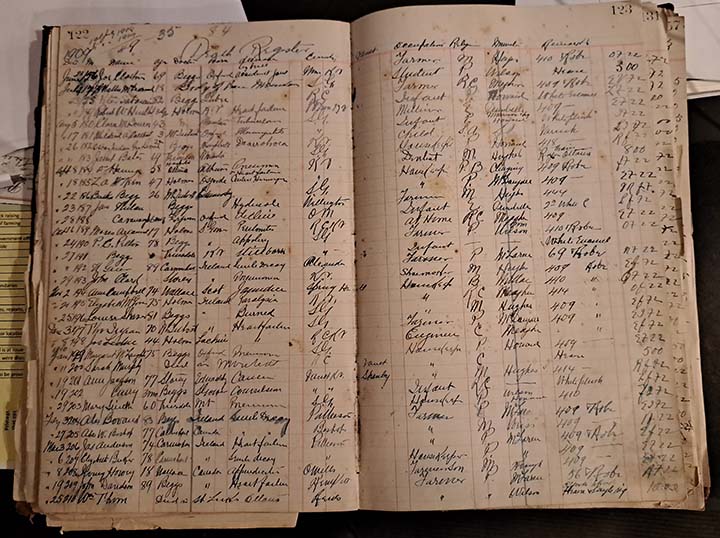It may seem an odd thing, but there’s always something new in history. Now and then, a document may be found, a diary, letter, or other record, that introduces us to someone in the past that was not previously known, or which sheds light on an individual, business, or event that provides insight into how our community was decades ago. A perfect example of this was brought to light recently, when a ledger was discovered in a box of miscellaneous documents in a cupboard in St. Paul’s Presbyterian Church in Kemptville. Roger Shantz sent it to me and explained how it had been found.
“I am the Chair of the Trustee Board at St John’s United. We were looking through some boxes that had been in storage for many years when we came across this book – which obviously did not have anything to do with church business. Other books were sent to church archives in Ottawa. No one knows how this one book ended up in the bottom of one of the boxes in the back of a little used closet.”

The ledger is a wonderful glimpse into a time when account books, registers, and other important documents were written in pen and ink (or even pencil), and were used to keep financial and official records, but also allowed the owner to add the occasional piece of information that had nothing to do with the real purpose of the ledger.
This document was a business ledger kept by George A. McCaughey between 1885 and 1914. George ran a furniture making business along with an undertaker’s service in Kemptville. That wasn’t actually an unusual combination of businesses at the time; after all, who else had access to wood for coffins! George had grown up on the family farm, lot 21 in the 10th Concession of Oxford, on land settled by his grandfather, David, who had arrived from Ireland with his wife and young son, George’s father.
In March, 1885, George, aged 25, married Nancy Elizabeth Graham, 26, who had been born in South Mountain. This was the same year the entries in the ledger began, and George is described in his marriage certificate as a “Merchant”. He had set up his business and residence on Prescott Street in Kemptville, where he and Nancy raised their family. As was so common in those days, two of their children died young. Their son, George, was born in 1888, but lived less than a month. John Vivien McCaughey, was less than 20 when he died in 1912. But their third son, S. J. McCaughey, survived and became a doctor in Ottawa.
The value of George’s ledger lies in the lists of customers who used his furniture business, but most especially the various records of deaths in the community for which he supplied undertaking services between 1914 and 1921. Here we have a comprehensive list consisting of names, date of death, age, where born, residence, cause of death, occupation, and other useful biographical information. A copy of these entries will be a valuable addition to the genealogical and social history of the region for those years straddling the First World War.
The McCaughey’s were Presbyterian, and George was involved in fundraising for the new church hall, choir loft, and vestry on Prescott Street from 1904. The history of St. Paul’s Presbyterian Church notes that the cost of the new additions was roughly $5,000, which it is calculated would be the equivalent of $500,000 today, though much depends on how that result is achieved. George’s accounts for the Building Fund between 1905 and 1913 are included in the ledger.
There are many other fascinating entries in the ledger, which will repay further analysis over the coming months. But the overall impact of the document is about George Adams McCaughey and his life and times in Kemptville between 1885 and 1928, when he and Nancy sold the business to Samuel Eldon Kidd and Clarence Lemuel Dickenson, who set up their own undertaking business, and who took care of George when he died on March 27, 1929. Nancy outlived him by almost a decade, and when she died on February 3, 1938, she joined him and many of their McCaughey relatives in the South Gower Cemetery.
It is remarkable how an entire family’s history can be recovered with the discovery of a single business ledger. At first sight, it may seem to be a rather dry and distant document; but, as often happens, a little further digging opens up an entirely new insight into those who came before us.





